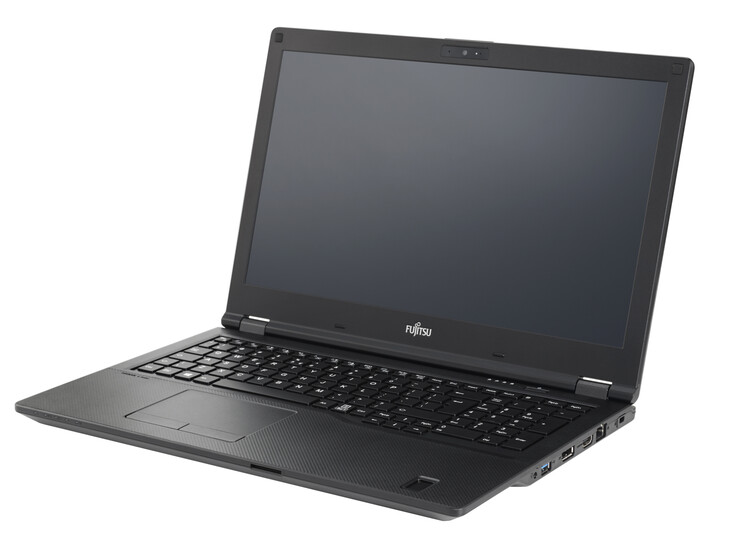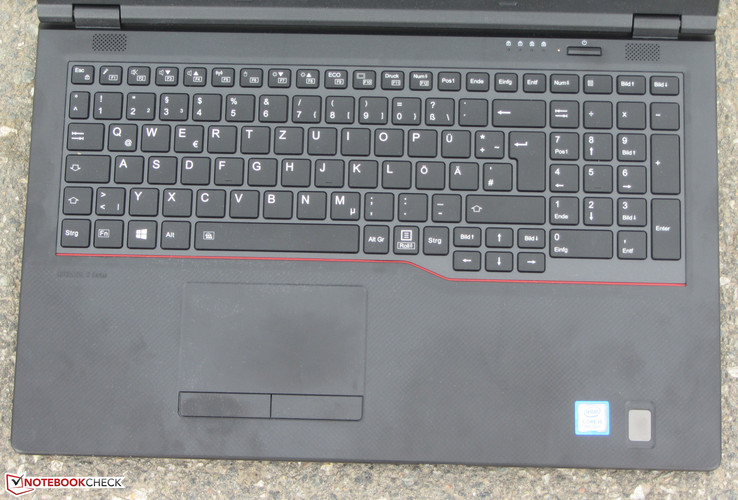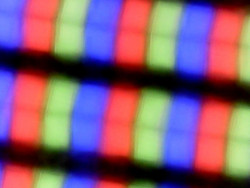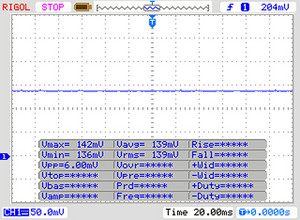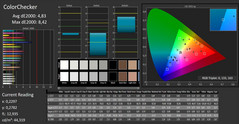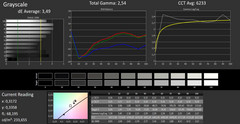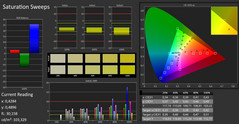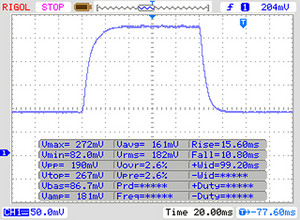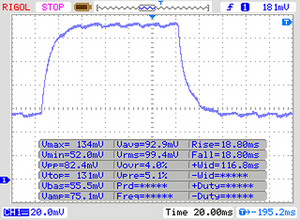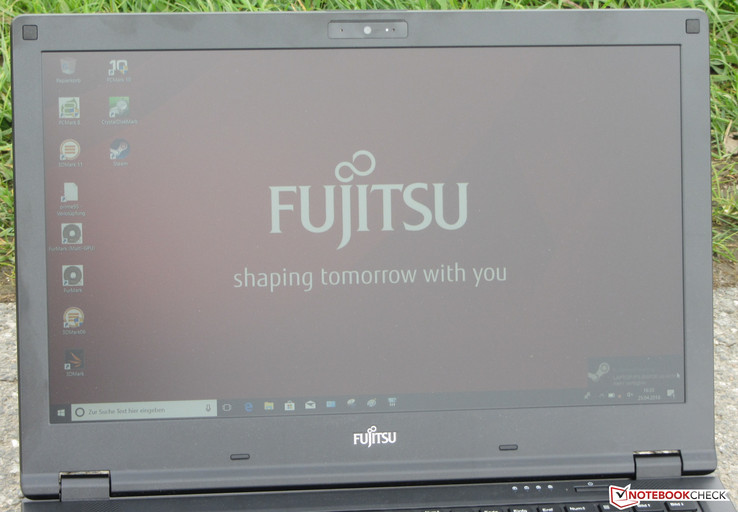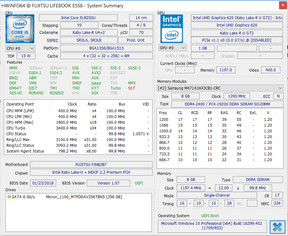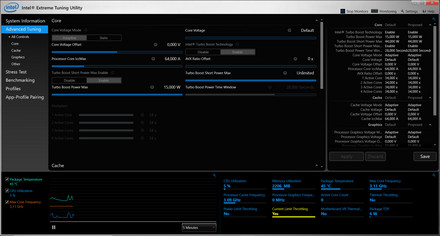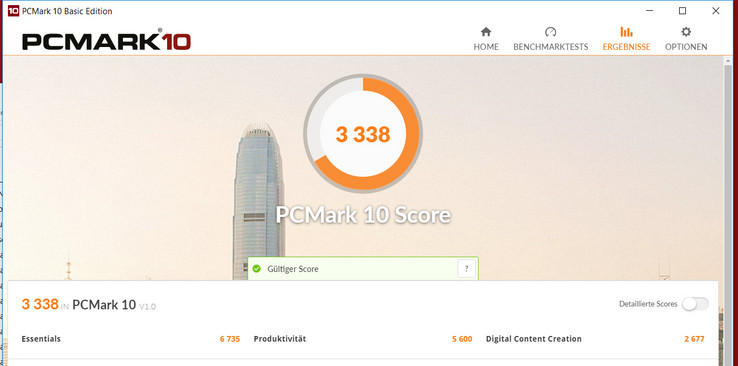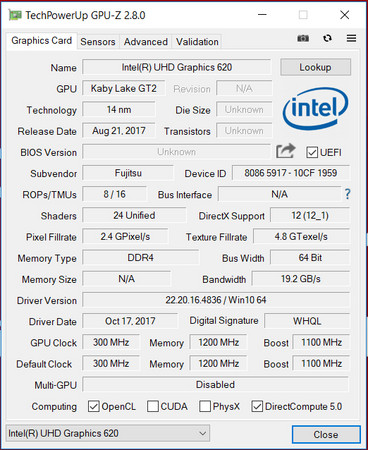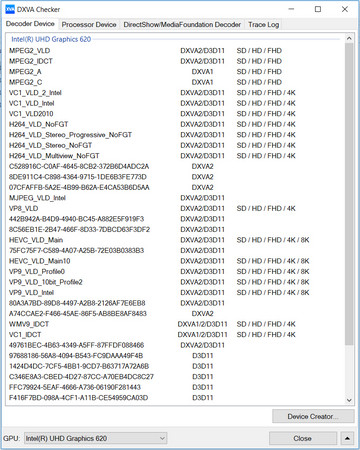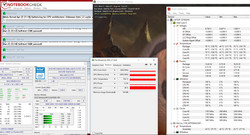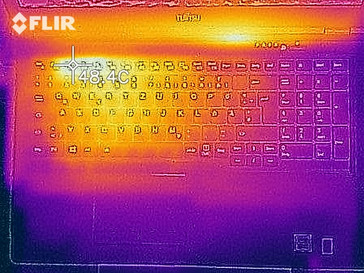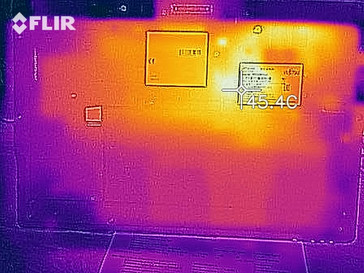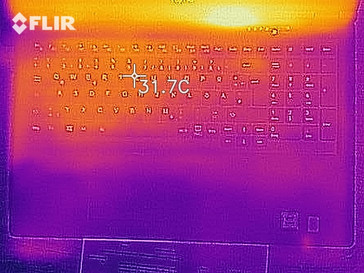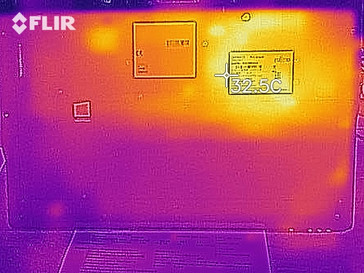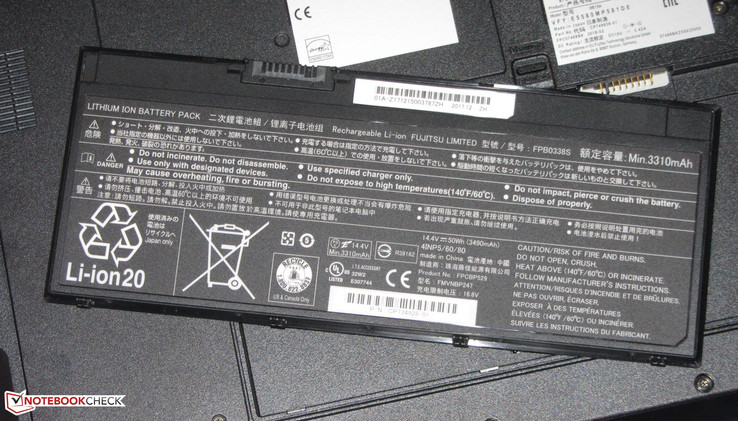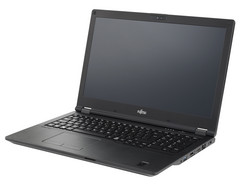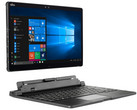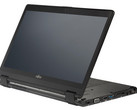Fujitsu LifeBook E558 (i5-8250U, SSD, FHD) Laptop Review

The LifeBook E558 is a 15.6-inch business notebook. We have already reviewed its direct predecessor, the LifeBook E557. The two devices are not identically built. With the E558, Fujitsu offers a new case and new ports. The laptop is powered by a quad-core ULV CPU from Intel. The competing devices of the E558 include: The Dell Latitude 5590, the HP ProBook 450 G5, the Lenovo ThinkPad E580, the HP ProBook 650 G3 and the Lenovo ThinkPad L580.
Case & Connectivity - The LifeBook E558 comes with a new case
With the E558, Fujitsu forgoes an optical disk drive. Therefore, the notebook is slimmer and lighter than the predecessor. There are no changes in terms of case materials: The case is made of matte black plastic. The build quality is solid. There are no defects. However, the case could have been somewhat more rigid. The chassis can be twisted when a significant amount of force is applied to it. This should not happen with a device with such a price tag. There is a maintenance cover on the underside of the device that enables access to the RAM, the SSD and the LTE module. The battery is not soldered-in. However, here Fujitsu relies on a new battery format. The batteries of the predecessors cannot be used with the E558.
The LifeBook E558 offers plenty of ports. The notebook comes with three USB 3.1 Gen 1 ports (two Type-A ports, one Type-C port). The laptop also features three ports for video output (HDMI, DisplayPort, VGA). Unlike with the predecessors, Fujitsu does not provide a serial port with this model. The selection of ports can be expanded with a docking station. However, the docking stations that were compatible with the predecessors of the E558 cannot be used with the new model. The built-in SD card reader works fast. When copying large chunks of data, a transfer rate of 76.5 MB/s was achieved. When copying 250 JPG image files (each approximately 5 MB in size), we observed an average speed of 60.6 MB/s. We test the SD card reader with the help of a reference SD card (Toshiba Exceria Pro SDXC 64 GB UHS-II).
The Wi-Fi module comes from Intel (Dual Band Wireless-AC 8265). Besides the Wi-Fi standards 802.11a/b/g/n, it also supports the fast AC standard. The data transfer speeds that we have measured under the optimal conditions (no other Wi-Fi-enabled devices in close proximity, a short distance between the notebook and the server PC) are in good order
Ports
| SD Card Reader | |
| average JPG Copy Test (av. of 3 runs) | |
| Dell Latitude 5590 (Toshiba Exceria Pro SDXC 64 GB UHS-II) | |
| HP ProBook 450 G5-2UB53EA (Toshiba Exceria Pro SDXC 64 GB UHS-II) | |
| Lenovo ThinkPad E580-20KSCTO1WW (Toshiba Exceria Pro M501) | |
| Fujitsu Lifebook E557 (Toshiba Exceria Pro SDXC 64 GB UHS-II) | |
| HP Probook 650 G3 Z2W44ET (Toshiba Exceria Pro SDXC 64 GB UHS-II) | |
| Fujitsu Lifebook E558 E5580MP581DE (Toshiba Exceria Pro SDXC 64 GB UHS-II) | |
| Average of class Office (22.4 - 198.5, n=28, last 2 years) | |
| maximum AS SSD Seq Read Test (1GB) | |
| Dell Latitude 5590 (Toshiba Exceria Pro SDXC 64 GB UHS-II) | |
| HP Probook 650 G3 Z2W44ET (Toshiba Exceria Pro SDXC 64 GB UHS-II) | |
| Fujitsu Lifebook E557 (Toshiba Exceria Pro SDXC 64 GB UHS-II) | |
| HP ProBook 450 G5-2UB53EA (Toshiba Exceria Pro SDXC 64 GB UHS-II) | |
| Lenovo ThinkPad E580-20KSCTO1WW (Toshiba Exceria Pro M501) | |
| Average of class Office (25 - 249, n=26, last 2 years) | |
| Fujitsu Lifebook E558 E5580MP581DE (Toshiba Exceria Pro SDXC 64 GB UHS-II) | |
Input Devices - The Fujitsu notebook features a keyboard backlight
Fujitsu has equipped the LifeBook with a chiclet-style backlit keyboard. The smooth, slightly concave keys have a short travel distance and a clear actuation point. During typing, the keyboard exhibits only a minimal amount of flex. The backlight is controlled with the function keys. It offers two brightness levels. Overall, Fujitsu delivers an “okay” keyboard, which has no trouble fulfilling its core functions.
The multitouch-enabled TouchPad occupies an area of some 9.9 x 6 cm (3.9 x 2.4 in). Therefore, there is enough space for the use of gesture controls. The slightly rough surface of the pad does not make finger gliding hard. Beneath the TouchPad, there are two separate easy-to-press mouse buttons. They have a short travel distance and a clear actuation point.
Display - The Fujitsu E558 offers a dim screen
The 15.6-inch display of the LifeBook operates with a native resolution of 1920x1080. The screen offers a good contrast ratio of 1444:1. However, the display brightness of 227.4 cd/m² is too low. Here, we would have liked to see a brightness of at least 300 cd/m². Most notebooks in this price range offer a display brightness of more than 300 cd/m². Positive: The screen does not suffer from PWM flickering.
| |||||||||||||||||||||||||
Brightness Distribution: 88 %
Center on Battery: 231 cd/m²
Contrast: 1444:1 (Black: 0.16 cd/m²)
ΔE ColorChecker Calman: 4.83 | ∀{0.5-29.43 Ø4.78}
ΔE Greyscale Calman: 3.49 | ∀{0.09-98 Ø5}
53% sRGB (Argyll 1.6.3 3D)
34% AdobeRGB 1998 (Argyll 1.6.3 3D)
36.43% AdobeRGB 1998 (Argyll 3D)
53% sRGB (Argyll 3D)
35.25% Display P3 (Argyll 3D)
Gamma: 2.54
CCT: 6233 K
| Fujitsu Lifebook E558 E5580MP581DE IPS, 1920x1080, 15.6" | Fujitsu Lifebook E557 TN LED, 1366x768, 15.6" | HP Probook 650 G3 Z2W44ET TN LED, 1920x1080, 15.6" | HP ProBook 450 G5-2UB53EA IPS LED, 1920x1080, 15.6" | Lenovo ThinkPad E580-20KSCTO1WW IPS LED, 1920x1080, 15.6" | Dell Latitude 5590 IPS, 1920x1080, 15.6" | |
|---|---|---|---|---|---|---|
| Display | 7% | 55% | 8% | 12% | 17% | |
| Display P3 Coverage (%) | 35.25 | 37.9 8% | 55.2 57% | 38.04 8% | 39.83 13% | 41.56 18% |
| sRGB Coverage (%) | 53 | 56.8 7% | 81.1 53% | 57.3 8% | 58.5 10% | 61.3 16% |
| AdobeRGB 1998 Coverage (%) | 36.43 | 39.15 7% | 57 56% | 39.31 8% | 41.15 13% | 42.93 18% |
| Response Times | -22% | -7% | -45% | -42% | -53% | |
| Response Time Grey 50% / Grey 80% * (ms) | 36 ? | 50 ? -39% | 38 ? -6% | 52.4 ? -46% | 48.4 ? -34% | 53.2 ? -48% |
| Response Time Black / White * (ms) | 25 ? | 26 ? -4% | 27 ? -8% | 36 ? -44% | 37.6 ? -50% | 39.6 ? -58% |
| PWM Frequency (Hz) | 210 ? | 200 ? | 22030 ? | 1000 ? | ||
| Screen | -60% | -67% | -29% | -21% | -25% | |
| Brightness middle (cd/m²) | 231 | 214 -7% | 351 52% | 252 9% | 292 26% | 243 5% |
| Brightness (cd/m²) | 227 | 213 -6% | 345 52% | 249 10% | 272 20% | 234 3% |
| Brightness Distribution (%) | 88 | 88 0% | 95 8% | 88 0% | 84 -5% | 83 -6% |
| Black Level * (cd/m²) | 0.16 | 0.53 -231% | 0.65 -306% | 0.22 -38% | 0.3 -88% | 0.19 -19% |
| Contrast (:1) | 1444 | 404 -72% | 540 -63% | 1145 -21% | 973 -33% | 1279 -11% |
| Colorchecker dE 2000 * | 4.83 | 7.93 -64% | 11.02 -128% | 6.9 -43% | 5.8 -20% | 6.6 -37% |
| Colorchecker dE 2000 max. * | 8.42 | 13.9 -65% | 17.68 -110% | 18.4 -119% | 22.4 -166% | 22.3 -165% |
| Greyscale dE 2000 * | 3.49 | 9.37 -168% | 13.14 -277% | 6.9 -98% | 2.3 34% | 5.2 -49% |
| Gamma | 2.54 87% | 2.32 95% | 2.7 81% | 2.43 91% | 2.12 104% | 2.24 98% |
| CCT | 6233 104% | 9971 65% | 16626 39% | 7524 86% | 6223 104% | 6990 93% |
| Color Space (Percent of AdobeRGB 1998) (%) | 34 | 36 6% | 52 53% | 36.3 7% | 37.6 11% | 39.2 15% |
| Color Space (Percent of sRGB) (%) | 53 | 56 6% | 81 53% | 57.2 8% | 58 9% | 60.8 15% |
| Colorchecker dE 2000 calibrated * | 5 | |||||
| Total Average (Program / Settings) | -25% /
-41% | -6% /
-34% | -22% /
-23% | -17% /
-17% | -20% /
-20% |
* ... smaller is better
Screen Flickering / PWM (Pulse-Width Modulation)
| Screen flickering / PWM not detected | |||
In comparison: 53 % of all tested devices do not use PWM to dim the display. If PWM was detected, an average of 8098 (minimum: 5 - maximum: 343500) Hz was measured. | |||
Display Response Times
| ↔ Response Time Black to White | ||
|---|---|---|
| 25 ms ... rise ↗ and fall ↘ combined | ↗ 15 ms rise | |
| ↘ 10 ms fall | ||
| The screen shows relatively slow response rates in our tests and may be too slow for gamers. In comparison, all tested devices range from 0.1 (minimum) to 240 (maximum) ms. » 58 % of all devices are better. This means that the measured response time is worse than the average of all tested devices (20.2 ms). | ||
| ↔ Response Time 50% Grey to 80% Grey | ||
| 36 ms ... rise ↗ and fall ↘ combined | ↗ 18 ms rise | |
| ↘ 18 ms fall | ||
| The screen shows slow response rates in our tests and will be unsatisfactory for gamers. In comparison, all tested devices range from 0.165 (minimum) to 636 (maximum) ms. » 49 % of all devices are better. This means that the measured response time is worse than the average of all tested devices (31.6 ms). | ||
Fujitsu has equipped the LifeBook E558 with an IPS panel with stable viewing angles. Therefore, the screen content can be read from any position. Outdoors, the device can only be used when the sun does not shine too brightly. The brightness is too low for use outside.
Performance - The E558 brings mid-range hardware to the table
The LifeBook E558 is a 15.6-inch business notebook. It offers more than enough performance for such usage scenarios as office work and Internet browsing. The laptop offers traditional business features such as the docking port and TPM. Our review device can be had for anywhere between 1100 and 1200 Euros ($1315-1435). At the time of this review, we could find only one other hardware configuration.
Processor
The LifeBook comes with a Core i5-8250U. It is a mid-range, quad-core ULV CPU from Intel with a TDP of 15 watts. The processor has a base clock of 1.6 GHz and a boost clock of 3.4 GHz.
In the multi-core section of the Cinebench R15 benchmark, the processor operates at 2.9 to 3.1 GHz for a short time. After that, the clock rate sinks to 2.3 to 2.4 GHz. In the single-core benchmarks, the CPU runs at 2.9 to 3.4 GHz. The processor performs identically both when the laptop is running on battery power and when it is plugged in.
We check if the Turbo boost can be used over an extended period of time by running the Cinebench multi-core benchmark in a continuous loop for 30 minutes. The results sink after the first benchmark run and remain stable thereafter. The Turbo boost operates at 2.3 to 2.4 GHz.
| Geekbench 3 | |
| 32 Bit Multi-Core Score | |
| Average Intel Core i5-8250U (10893 - 13553, n=18) | |
| Fujitsu Lifebook E558 E5580MP581DE | |
| HP Probook 650 G3 Z2W44ET | |
| 32 Bit Single-Core Score | |
| Average Intel Core i5-8250U (3148 - 3503, n=18) | |
| Fujitsu Lifebook E558 E5580MP581DE | |
| HP Probook 650 G3 Z2W44ET | |
| Geekbench 4.4 | |
| 64 Bit Multi-Core Score | |
| Average of class Office (16566 - 41544, n=11, last 2 years) | |
| Average Intel Core i5-8250U (11269 - 14228, n=25) | |
| Fujitsu Lifebook E558 E5580MP581DE | |
| 64 Bit Single-Core Score | |
| Average of class Office (4469 - 8042, n=11, last 2 years) | |
| Average Intel Core i5-8250U (3453 - 4330, n=25) | |
| Fujitsu Lifebook E558 E5580MP581DE | |
| JetStream 1.1 - Total Score | |
| HP ProBook 450 G5-2UB53EA (Edge) | |
| Fujitsu Lifebook E558 E5580MP581DE (Edge 41) | |
| Dell Latitude 5590 (Edge 41.16299.248.0) | |
| Average Intel Core i5-8250U (151.5 - 256, n=78) | |
| HP Probook 650 G3 Z2W44ET (Edge 38) | |
| Lenovo ThinkPad E580-20KSCTO1WW (Edge 41.16299.248.0) | |
| Fujitsu Lifebook E557 | |
System Performance
An SSD and a powerful quad-core processor create a very responsive system. The laptop has more than enough computing power for such usage scenarios as office work and web browsing. The very good results in the PCMark benchmarks confirm this. A small increase in the overall performance can be achieved by installing a second RAM module (= enabling dual-channel mode).
| PCMark 8 Home Score Accelerated v2 | 3464 points | |
| PCMark 8 Creative Score Accelerated v2 | 4499 points | |
| PCMark 8 Work Score Accelerated v2 | 4525 points | |
| PCMark 10 Score | 3338 points | |
Help | ||
Storage Devices
Fujitsu has put a SATA-III SSD from Micron in the LifeBook E558. It comes in the M.2-2280 form factor and has a capacity of 256 GB. Only 202 GB thereof is available to the user. The rest of the storage space is occupied by the Windows installation files and the recovery partition. The transfer rates are decent.
| Fujitsu Lifebook E558 E5580MP581DE Micron 1100 MTFDDAV256TBN | Fujitsu Lifebook E557 Toshiba THNSNK256GCS8 | HP Probook 650 G3 Z2W44ET Hitachi Travelstar Z7K500 HTS725050A7E630 | HP ProBook 450 G5-2UB53EA SanDisk SD8SN8U256G1006 | Lenovo ThinkPad E580-20KSCTO1WW Toshiba KBG30ZMT128G | Dell Latitude 5590 SK hynix SC311 M.2 | Average Micron 1100 MTFDDAV256TBN | Average of class Office | |
|---|---|---|---|---|---|---|---|---|
| CrystalDiskMark 3.0 | -12% | -91% | -4% | 11% | 6% | -4% | 289% | |
| Read Seq (MB/s) | 458.8 | 417.2 -9% | 109.4 -76% | 502 9% | 916 100% | 498.8 9% | 465 ? 1% | 3104 ? 577% |
| Write Seq (MB/s) | 378.7 | 262.6 -31% | 99.9 -74% | 451.6 19% | 135 -64% | 436.4 15% | 379 ? 0% | 2916 ? 670% |
| Read 512 (MB/s) | 332.2 | 389.5 17% | 16.34 -95% | 372.5 12% | 787 137% | 352.9 6% | 315 ? -5% | 899 ? 171% |
| Write 512 (MB/s) | 325.1 | 263 -19% | 43.45 -87% | 269.7 -17% | 134.3 -59% | 322.8 -1% | 315 ? -3% | 2309 ? 610% |
| Read 4k (MB/s) | 26.48 | 17.5 -34% | 0.337 -99% | 27.76 5% | 33.34 26% | 29.11 10% | 24.6 ? -7% | 54.1 ? 104% |
| Write 4k (MB/s) | 78 | 60.6 -22% | 0.866 -99% | 52.4 -33% | 92.4 18% | 74.5 -4% | 80.8 ? 4% | 114.1 ? 46% |
| Read 4k QD32 (MB/s) | 246.6 | 311.4 26% | 0.826 -100% | 260.2 6% | 199.2 -19% | 276.4 12% | 227 ? -8% | 463 ? 88% |
| Write 4k QD32 (MB/s) | 259.9 | 201.1 -23% | 0.859 -100% | 177.7 -32% | 118.8 -54% | 267 3% | 233 ? -10% | 370 ? 42% |
Graphics Card
The E558 does not offer a dedicated graphics card. Intel’s UHD Graphics 620 is used for image rendering. Intel’s chip supports DirectX 12 and runs at anywhere between 300 and 1100 MHz. The results in the 3DMark benchmarks are on the normal level for this kind of GPU. Through the activation of the dual-channel mode, an increase in performance can be achieved, because in that case the graphics unit can be better utilized. This will require installation of a second RAM module.
| 3DMark 11 Performance | 1719 points | |
| 3DMark Cloud Gate Standard Score | 7057 points | |
| 3DMark Fire Strike Score | 872 points | |
Help | ||
Gaming Performance
Even though the LifeBook E558 is mainly an office notebook, it can still run some games smoothly. This applies to titles that have low system requirements. However, one will have to be content with running these games at low resolutions and with low graphical settings. An increase in gaming performance can be achieved through the activation of the dual-channel mode.
| low | med. | high | ultra | |
|---|---|---|---|---|
| BioShock Infinite (2013) | 44.8 | 25.3 | 20.9 | 7.5 |
Emissions & Energy Management
System Noise
The LifeBook E558 does not produce too much noise. When idle, the fan often stands still, which leads to silent operation. Under full load, the fan does not spin especially fast. During the stress test, we measured a sound pressure level of 33.5 dB(A). Reason: The CPU and the GPU operate at low frequencies. The fan is somewhat louder under medium load (34.8 dB(A)).
Noise level
| Idle |
| 30 / 30 / 30 dB(A) |
| Load |
| 34.8 / 33.5 dB(A) |
 | ||
30 dB silent 40 dB(A) audible 50 dB(A) loud |
||
min: | ||
Temperature
The LifeBook E558 completes our stress test (Prime95 and FurMark running continuously for at least one hour) with similar results, both when plugged in and when running on battery power: The processor operates at 1.8 to 1.9 GHz. The GPU runs at 550 MHz.
The notebook does not become excessively hot. During the stress test, the 40 °C (104 °F) mark is exceeded only at two measurement points.
(±) The maximum temperature on the upper side is 42 °C / 108 F, compared to the average of 34.3 °C / 94 F, ranging from 21.2 to 62.5 °C for the class Office.
(±) The bottom heats up to a maximum of 41 °C / 106 F, compared to the average of 36.8 °C / 98 F
(+) In idle usage, the average temperature for the upper side is 25.7 °C / 78 F, compared to the device average of 29.5 °C / 85 F.
(+) The palmrests and touchpad are cooler than skin temperature with a maximum of 26.6 °C / 79.9 F and are therefore cool to the touch.
(±) The average temperature of the palmrest area of similar devices was 27.6 °C / 81.7 F (+1 °C / 1.8 F).
Speakers
The stereo speakers are located on the underside of the device behind a perforated cover. They produce an okay sound, to which one can listen for a long time. However, the sound almost completely lacks bass. For a better listening experience, we recommend using external speakers or headphones.
Fujitsu Lifebook E558 E5580MP581DE audio analysis
(-) | not very loud speakers (67 dB)
Bass 100 - 315 Hz
(-) | nearly no bass - on average 27.9% lower than median
(±) | linearity of bass is average (7.5% delta to prev. frequency)
Mids 400 - 2000 Hz
(+) | balanced mids - only 3.6% away from median
(±) | linearity of mids is average (9.8% delta to prev. frequency)
Highs 2 - 16 kHz
(+) | balanced highs - only 2.9% away from median
(+) | highs are linear (5.3% delta to prev. frequency)
Overall 100 - 16.000 Hz
(±) | linearity of overall sound is average (25.7% difference to median)
Compared to same class
» 78% of all tested devices in this class were better, 7% similar, 15% worse
» The best had a delta of 7%, average was 21%, worst was 53%
Compared to all devices tested
» 78% of all tested devices were better, 5% similar, 17% worse
» The best had a delta of 4%, average was 24%, worst was 134%
Apple MacBook 12 (Early 2016) 1.1 GHz audio analysis
(+) | speakers can play relatively loud (83.6 dB)
Bass 100 - 315 Hz
(±) | reduced bass - on average 11.3% lower than median
(±) | linearity of bass is average (14.2% delta to prev. frequency)
Mids 400 - 2000 Hz
(+) | balanced mids - only 2.4% away from median
(+) | mids are linear (5.5% delta to prev. frequency)
Highs 2 - 16 kHz
(+) | balanced highs - only 2% away from median
(+) | highs are linear (4.5% delta to prev. frequency)
Overall 100 - 16.000 Hz
(+) | overall sound is linear (10.2% difference to median)
Compared to same class
» 7% of all tested devices in this class were better, 2% similar, 91% worse
» The best had a delta of 5%, average was 18%, worst was 53%
Compared to all devices tested
» 4% of all tested devices were better, 1% similar, 94% worse
» The best had a delta of 4%, average was 24%, worst was 134%
Energy Consumption
There are no abnormalities in terms of energy consumption to report. When idle, we measured a maximum power draw of 8.3 watts. During the stress test, the energy consumption peaked at 36.7 watts. The rated output of the AC adapter amounts to 65 watts.
| Off / Standby | |
| Idle | |
| Load |
|
Key:
min: | |
Battery Life
Our practically oriented Wi-Fi test simulates loads that are consistent with surfing the Internet. The “balanced” power plan is selected, the energy-saving functions are disabled and the display brightness is set to 150 cd/m². The LifeBook achieves a battery runtime of 7 hours and 9 minutes. Therefore, it lasts significantly longer than the predecessor (4 hours and 30 minutes).
Pros
Cons
Verdict
The LifeBook E558 is a 15.6-inch business notebook. Just like the competition, Fujitsu utilizes ULV quad-core CPUs from Intel. Therefore, the laptop offers enough computing power for business applications. Moreover, the device operates quietly regardless of the load.
An SSD creates a very responsive system. Replacing the SSD is not hard, because it is located behind a maintenance hatch. The notebook offers plenty of ports. The selection of ports can be expanded with a docking station.
The keyboard has left a positive impression and is fit for regular office work. It also features a backlight. A connection to the Internet can be established not only via Ethernet and Wi-Fi, but also through LTE. Additionally, the notebook also offers good battery life.
The LifeBook E558 is a well-rounded business laptop. Despite a high price tag, it evinces flaws that could have been avoided.
The matte IPS screen delights with stable viewing angles and good contrast. However, the display brightness proves too low when compared to other devices in this price range. The case deserves criticism. Here we are not talking about the choice of materials, but rather about the lack of rigidity: The chassis can be twisted to a considerable extent. Such a flaw should not crop up in a notebook that costs more than 1000 Euros ($1198).
Users who are already familiar with the LifeBook E557 and E556 will have to contend with some changes: The case is slimmer and lighter, because Fujitsu no longer provides an optical disk drive. Additionally, the docking stations that were usable with the predecessors are not compatible with the new model. The serial port is also gone. It is no longer available according to Fujitsu’s website.
Fujitsu Lifebook E558 E5580MP581DE
- 05/01/2018 v6 (old)
Sascha Mölck




